Sialic acid modification of adiponectin is not required for multimerization or secretion but determines half-life in circulation
- PMID: 19855092
- PMCID: PMC5428139
- DOI: 10.1210/me.2009-0133
Sialic acid modification of adiponectin is not required for multimerization or secretion but determines half-life in circulation
Abstract
Adiponectin is an adipocyte-secreted, insulin-sensitizing hormone the circulating levels of which are reduced in conditions of insulin resistance and diabetes. Previous work has demonstrated the importance of posttranslational modifications, such as proline hydroxylation and lysine hydroxylation/glycosylation, in adiponectin oligomerization, secretion, and function. Here we describe the first functional characterization of adiponectin sialylation. Using a variety of biochemical approaches we demonstrated that sialylation occurs on previously unidentified O-linked glycans on Thr residues of the variable domain in human adiponectin. Enzymatic removal of sialic acid or its underlying O-linked sugars did not affect adiponectin multimer composition. Expression of mutant forms of adiponectin (lacking the modified Thr residues) or of wild-type adiponectin in cells defective in sialylation did not compromise multimer formation or secretion, arguing against a structural role for this modification. Activity of desialylated adiponectin was comparable to control adiponectin in L6 myotubes and acute assays in adiponectin(-/-) mice. In contrast, plasma clearance of desialylated adiponectin was accelerated compared with that of control adiponectin, implicating a role for this modification in determining the half-life of circulating adiponectin. Uptake of desialylated adiponectin by isolated primary rat hepatocytes was also accelerated, suggesting a role for the hepatic asialoglycoprotein receptor. Finally, after chronic administration in adiponectin(-/-) mice steady-state levels of desialylated adiponectin were lower than control adiponectin and failed to recapitulate the improvements in glucose and insulin tolerance tests observed with control adiponectin. These data suggest an important role for sialic acid content in the regulation of circulating adiponectin levels and highlight the importance of understanding mechanisms regulating adiponectin sialylation/desialylation.
Figures
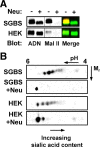
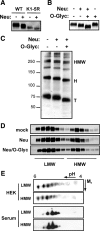
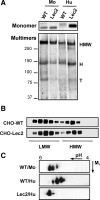

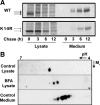

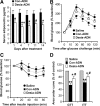
Similar articles
-
Adiponectin multimerization is dependent on conserved lysines in the collagenous domain: evidence for regulation of multimerization by alterations in posttranslational modifications.Mol Endocrinol. 2006 Jul;20(7):1673-87. doi: 10.1210/me.2005-0390. Epub 2006 Feb 23. Mol Endocrinol. 2006. PMID: 16497731
-
Post-translational modifications of the four conserved lysine residues within the collagenous domain of adiponectin are required for the formation of its high molecular weight oligomeric complex.J Biol Chem. 2006 Jun 16;281(24):16391-400. doi: 10.1074/jbc.M513907200. Epub 2006 Apr 18. J Biol Chem. 2006. PMID: 16621799
-
The activities of lysyl hydroxylase 3 (LH3) regulate the amount and oligomerization status of adiponectin.PLoS One. 2012;7(11):e50045. doi: 10.1371/journal.pone.0050045. Epub 2012 Nov 29. PLoS One. 2012. PMID: 23209641 Free PMC article.
-
Adiponectin--it's all about the modifications.Int J Biochem Cell Biol. 2010 Jun;42(6):785-8. doi: 10.1016/j.biocel.2009.12.021. Epub 2010 Jan 4. Int J Biochem Cell Biol. 2010. PMID: 20044026 Review.
-
[Clinical and diagnostic significance of sialic acids determination in biological material].Biomed Khim. 2022 Jan;68(1):7-17. doi: 10.18097/PBMC20226801007. Biomed Khim. 2022. PMID: 35221292 Review. Russian.
Cited by
-
Inhibition of ERK1/2 pathway suppresses adiponectin secretion via accelerating protein degradation by Ubiquitin-proteasome system: relevance to obesity-related adiponectin decline.Metabolism. 2013 Aug;62(8):1137-48. doi: 10.1016/j.metabol.2013.01.025. Epub 2013 Mar 12. Metabolism. 2013. PMID: 23490586 Free PMC article.
-
Adiponectin and cardiovascular health: an update.Br J Pharmacol. 2012 Feb;165(3):574-90. doi: 10.1111/j.1476-5381.2011.01395.x. Br J Pharmacol. 2012. PMID: 21457225 Free PMC article. Review.
-
Snail destabilizes cell surface Crumbs3a.Traffic. 2012 Aug;13(8):1170-85. doi: 10.1111/j.1600-0854.2012.01376.x. Epub 2012 May 28. Traffic. 2012. PMID: 22554228 Free PMC article.
-
Adiponectin-Consideration for its Role in Skeletal Muscle Health.Int J Mol Sci. 2019 Mar 27;20(7):1528. doi: 10.3390/ijms20071528. Int J Mol Sci. 2019. PMID: 30934678 Free PMC article. Review.
-
The Effects of Brown Algae-Derived Monosaccharide L-Fucose on Lipid Metabolism in C57BL/6J Obese Mice.Nutrients. 2020 Dec 11;12(12):3798. doi: 10.3390/nu12123798. Nutrients. 2020. PMID: 33322300 Free PMC article.
References
-
- Weyer C, Funahashi T, Tanaka S, Hotta K, Matsuzawa Y, Pratley RE, Tataranni PA2001. Hypoadiponectinemia in obesity and type 2 diabetes: close association with insulin resistance and hyperinsulinemia. J Clin Endocrinol Metab 86:1930–1935 - PubMed
-
- Kern PA, Di Gregorio GB, Lu T, Rassouli N, Ranganathan G2003. Adiponectin expression from human adipose tissue: relation to obesity, insulin resistance, and tumor necrosis factor-α expression. Diabetes 52:1779–1785 - PubMed
-
- Maeda N, Shimomura I, Kishida K, Nishizawa H, Matsuda M, Nagaretani H, Furuyama N, Kondo H, Takahashi M, Arita Y, Komuro R, Ouchi N, Kihara S, Tochino Y, Okutomi K, Horie M, Takeda S, Aoyama T, Funahashi T, Matsuzawa Y2002. Diet-induced insulin resistance in mice lacking adiponectin/ACRP30. Nat Med 8:731–737 - PubMed
-
- Waki H, Yamauchi T, Kamon J, Ito Y, Uchida S, Kita S, Hara K, Hada Y, Vasseur F, Froguel P, Kimura S, Nagai R, Kadowaki T2003. Impaired multimerization of human adiponectin mutants associated with diabetes: molecular structure and multimer formation of adiponectin. J Biol Chem 278:40352–40363 - PubMed
Publication types
MeSH terms
Substances
LinkOut - more resources
Full Text Sources
Other Literature Sources
Molecular Biology Databases
Miscellaneous

